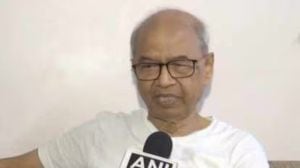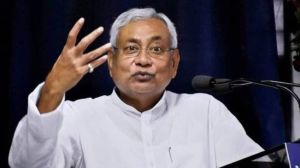Holding on to the Centre
As the Congress dithers over the nuclear deal, at stake is the party’s political record as the custodian of India’s national interests.

As the Congress dithers over the nuclear deal, at stake is the party’s political record as the custodian of India’s national interests. If it gives up on a historic diplomatic initiative in order to please the communists, the Congress might survive in power for a few more months but will betray its own nuclear and nationalist legacies.
Some in the Congress say the negotiations with the Left are not just about avoiding early polls but keeping the communists on its side after the next general elections. Implied in this are two dangerous propositions. One is that the political future of the Congress is inextricably tied to a long-term alliance with the communists. The other is that the Congress must for ever cede a veto to the communists over India’s foreign and security policies.
Accepting these propositions would imply that the Congress might voluntarily vacate the national centre ground that it has dominated for more than a century. No one will blame the communists for wanting to extract an ideological pound of flesh from the Congress. But where does the Congress stand on the future of India’s nuclear programme and national security?
A quick review of India’s nuclear history suggests that Congress prime ministers took all the major decisions on India’s nuclear programme, except the one on Pokharan II in May 1998 that was taken by the BJP’s Atal Bihari Vajpayee. It was Jawaharlal Nehru who founded India’s nuclear programme nearly 60 years ago, paving the way for both a civilian nuclear programme and a military option. It was Indira Gandhi’s turn to conduct India’s first nuclear test in 1974 and demonstrate India’s weapon potential. When she returned to power in 1980, she reversed the unacceptable decision by the Morarji Desai government to freeze India’s nuclear programme during 1977-79.
It was Rajiv Gandhi who ended India’s nuclear ambiguity and ordered the manufacture of atomic weapons in the late ’80s. P.V. Narasimha Rao prepared the ground for the second round of nuclear tests and the development of the hydrogen bomb.
In comparison to the international odds against which the earlier Congress leaders were asked to sustain the nuclear programme, Sonia Gandhi and Manmohan Singh have had a relatively easy task — of implementing an agreement that restores India’s rightful place in the global nuclear order. It is an agreement backed by all the major powers in the world except China.
This is also an agreement that marks the culmination of diplomatic efforts by all previous governments since 1974 when nuclear sanctions began to bite India. Yet the Congress is abjectly wringing its hands and avoiding a final call despite the rapidly shrinking international time lines for the implementation of the civil nuclear initiative.
The communists have also made it abundantly clear that their objections are not just to the nuclear deal but about the very engagement with the US. In that sense the communists want to fundamentally circumscribe India’s foreign policy options. No Indian government that is worth its salt will ever accept such dictation on foreign policy from a political formation that has never been part of mainstream thinking on national security.
The Congress never defined non-alignment as “anti-Americanism”. That is the meaning injected into non-alignment by the communists who were late converts to the concept after having denounced Nehru in the ’50s for not taking sides in the Cold War between the East and the West.
Nehru, Indira, and Rajiv never viewed India’s strategic programmes from an ideological perspective. Nehru, who authored India’s non-alignment, did not hesitate to turn to the US to build India’s first research reactors, and to sign the contract with America’s General Electric company to build the nation’s first nuclear power station in Tarapur.
During the Nehru period, the Soviet Union certainly helped India develop heavy industry. But the US and the West were India’s first choices in expanding the domestic science and technology base. India’s nuclear and space programmes, as well as the green revolution in the ’60s, were launched with Western and American cooperation. The US, the United Kingdom and Germany helped found the first Indian Institutes of Technology (IITs).
Even during the most difficult periods of India’s relations with the US, India never gave up on bilateral science and technology cooperation. Barely three years after the war to liberate Bangladesh in 1971, which saw the lowest ebb in Indo-US ties, Indira launched a Joint Indo-US Commission on Science and Technology. Indira also ended the impasse on American supply of enriched uranium fuel to Tarapur in 1982 and signed a memorandum of understanding with the
US to ease dual-use technology transfers in 1984.
Rajiv Gandhi further pressed the initiative to expand advanced technology cooperation with the US, including the purchase of an American super-computer for meteorological research in the mid-’80s. Rajiv also opened the defence sector for cooperation with the US for the first time through joint programmes in the development of light combat aircraft.
The communist argument that high-technology cooperation with the US is a departure from India’s foreign policy tradition is a political slogan that has little resemblance to truth.
The Congress is on a fool’s errand if it thinks it can finesse the communists on India’s nuclear future or the importance of a partnership with the US. It can either stand up for what is right or accept the ideological hegemony of the Communists. If it chooses the latter suicidal course, the Congress would be sending out an open invitation to the BJP to become the sole spokesman of India’s national security interests.
The writer is Professor of South Asian Studies at the S. Rajaratnam School of International Studies, Nanyang Technological University, Singapore iscrmohan@ntu.edu.sg





- 01
- 02
- 03
- 04
- 05


























